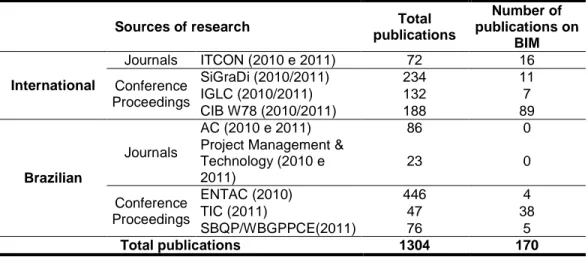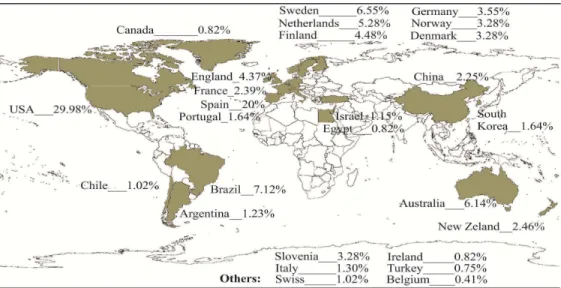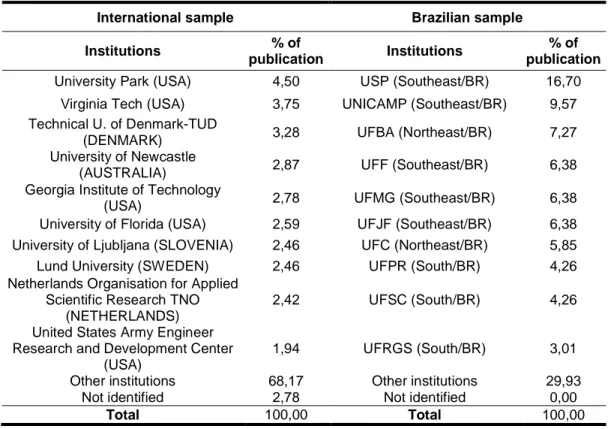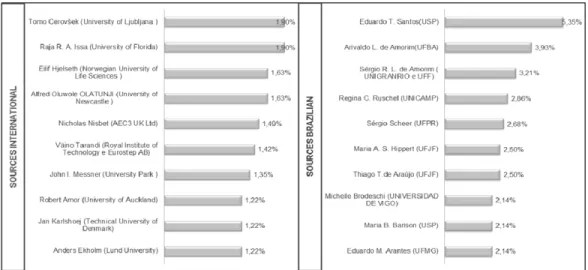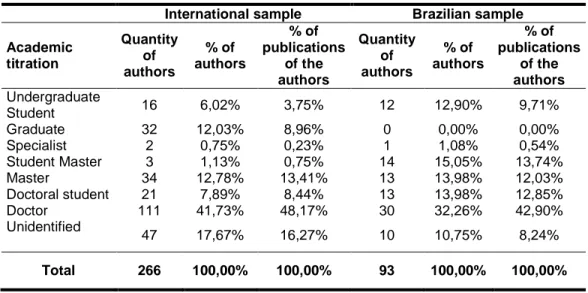ABROAD
Thaís M. Carneiro1, Deborah M. de O. Lins2 and José de Paula Barros Neto3.
ABSTRACT
This paper is a bibliometric research that aim to compare Brazilian and international scenario in BIM technology in the last two years. The study aims to search for the best-known authors; the amount of their publications; academic authors titles that appear more frequently; identify which institutions publish more articles, both in Brazil and abroad; and detect which countries invest more in research on the subject under examination. To this end, a research was carried out in articles published in annals of events and national and international academic journals specifically in the years 2010 and 2011. The articles should contain in their titles, abstracts or keywords at least one of the 13 terms considered necessary to be selected for analysis. It was concluded that despite being incipient, studies on BIM have been evolved, showing an increasing number of academic research. In that context, Brazil had an important participation in international publications, as well as foreign universities have also contributed to publications on BIM in Brazilian events.
KEYWORDS
Collaboration, BIM, bibliometric research, virtual building.
INTRODUTION
The number of articles published and researchers in the area of information technology in construction has increased in recent years. One of the ways to convey knowledge is through scientific disclosure: a research paper should be published and thus the results could be known and discussed in academia. A research in AEC area is necessary to perform searches which explore the theme "Building Information Modeling" concerning the assessment of scientific productivity. The occurrence of the approach of this theme has increased in recent years, along with the awareness of professionals as to its benefits.
For Kobashi and Santos (2005), Bibliometrics is a census methodology of scientific activities performed from analysis of data that are gathered by showing the same characteristics. The analysis of scientific literature, citations and content produced constitute the object of Bibliometrics (Garfield 1973; Price 1965; Zhao
1
Civil Engineer, Master student, Program of postgraduate in Civil Engineering, UFC, Campus of Pici, 710 Block, Fortaleza, Brazil, Phone: +55085 33669607, thaismarilane@gmail.com
2
Architect and Urban Planner, Master student, Program of postgraduate in Civil Engineering, UFC, Campus of Pici, 710 Block, Fortaleza, Brazil, Phone: +55085 33669607, deborahmo@gmail.com 3
2006). From this concept, the discipline comes to quantify the written communication, using varying processes of lifting, treatment and presentation of data.
Measure the scientific activity allows to target the focus of research, strengthening the efforts employed in the performance of its duties, as well as to support discussions on the progress and the quality of the search. By Bibliometrics understood that is the "study of the quantitative aspects of the production, dissemination and use of recorded information" (Tague-Sutcliffe 1992). Bibliometrics research can be applied in various areas of knowledge, and the specific production of a country in relation to the world, an institution to your country or scientists to its community.
Given this, it is assumed that the bibliometric research helps guiding new researches on BIM, since it identifies and review the demands for future studies. This paper presents the hypothesis that Brazil has increased its scientific production, especially in the last two years.
In this bibliometric research, the objective is to draw an analytical overview of scientific literature on the subject BIM in certain events and magazines from Brazil and abroad over the past two years, in order to compare these.
BUILDING INFORMATION MODELING
According to Crespo and Ruschel (2007), the BIM presents himself as a new generation of object-oriented Intelligent CAD tools that manage the construction information.
Software products that have BIM technology presents special characteristics as: 3D modeling, automatic generation of drawings, smart components parametrize, relational database, implementation of the time attribute in the processes of construction and interoperability, which requires a standardization in protocols for communication software (Eastman et al. 2008).
Thus, the BIM goes far beyond a 3D modeling, it provides not only the 3-d view of the building, but it is also possible to generate all the necessary documents for the construction without subjective inferences of designers. In the case of 3D CAD models only, in which do not display function and behavior, it cannot be regarded as information templates construction (Sacks et al. 2009).
The BIM technology should be seen as a tool to increase the quality of projects (Hippert and Araújo 2010). But, coupled to this, has as a consequence the improvement of the whole construction process, making it more streamlined and lean. According to Ferreira (2007), the BIM is a building information model, in which the concept is to treat the information of construction from conception to operation, maintenance and demolition. In other words, modeling is not confined only to the design phase, but follows through the whole life cycle of the building. Sousa (2010) states that the BIM presents itself as an extremely powerful tool, since it helps eliminate errors in the design of the project, and determine methods of construction and better cost-benefit ratio, which favors the lean construction.
BIM provides the basis for new construction capabilities and changes in the roles and relationships among a project team. When implemented appropriately, BIM facilitates a more integrated design and construction process that results in better quality buildings at lower cost and reduced project duration. In this sense, BIM is expected to provide the foundation for some of the results that lean construction is expected to deliver (Eastman et al. 2008)
Therefore, it is of great importance that the Building Information Modeling has to be applied in a globalized way, so that the construction area, which is so marked by errors of projects and budgets, may evolve with regard to improve the production process as a whole.
METHODOLOGY
As a bibliometric research, it is characterized as an exploratory study, descriptive and documentary, using the deductive method. At first, was studied other works with the same contents, to guide this paper´s structure. Therefore, a literature review was conducted on BIM and its relationship with lean. After that, begun the withdrawal phase by sampling and data tabulation, to finally, conclude the analysis of the results obtained.
As the basis for data collection, were chosen three conference proceedings and two journals of Architecture, Engineering and Construction (AEC) to characterize the Brazilian scientific production. To illustrate the international scene, were also chosen three conference proceedings and a foreign journal, always comparing with the national scene. Through these, the databases indicated the representative participation by continent, shown in this article.
The choice of the analysis period (2010 and 2011) is justified by the existence of a bibliometric research on the subject, titled "The diffusion of BIM Technologies by researchers from Brazil" Checcucci et al (2011). The Checcucci´s article presents as a baseline, the years of 2005 to 2010. However, this article is not exactly a complement of the paper above.
Due to the large amount of articles found, neither the analysis of their contents, nor its ranking for specific thematic were discussed. In relationship with relevant information to this search, the data were collected directly from the published article. In the absence of any information on the publication itself, a search was carried out on sites of the universities where researchers work, once the search is recent. It was used the terminology "unidentified" in the case of the information sought is not present in any of the two cases cited above.
For collecting articles about BIM, were chosen thirteen keywords that seemed the most during the literature review on the subject (see frame 01). Thus, was found the presence of at least one of these in the title, in the abstract and/or keywords of all articles from the selected search sources. During the searches, other articles were found with one of the chosen keywords in the body of work, however didn´t follow the previously determined rule. In this way, these articles have not been accounted for.
Frame 01: Keywords sought in the works
Keywords searched in Articles
BIM Modelo 4D
Building Information Model Model 4D Building Information Modeling Cad nD Building Information Models IFC
Building Information Modelling Interoperability Modelagem de Informações da Construção Interoperabilidade Modelo de Informações da Construção
CHARACTERIZATION OF SOURCES OF RESEARCH AND ANALYSIS OF THE SAMPLE
In Table 01 is possible to verify the sources surveyed and the number of publications found. Within this universe of Brazilian and foreign events and periodicals, 1304 articles were examined and found 170 within the criteria laid down above, representing about 13% of the sample.
Table 01: Sources of research x total publications x number of publications on BIM
Sources of research Total publications
Number of publications on
BIM
International
Journals ITCON (2010 e 2011) 72 16 Conference
Proceedings
SiGraDi (2010/2011) 234 11 IGLC (2010/2011) 132 7 CIB W78 (2010/2011) 188 89
Brazilian
Journals
AC (2010 e 2011) 86 0 Project Management &
Technology (2010 e 2011)
23 0
Conference Proceedings
ENTAC (2010) 446 4 TIC (2011) 47 38 SBQP/WBGPPCE(2011) 76 5
Total publications 1304 170
For the purposes of characterization of the sample, below is a brief description of the Brazilian and foreign research sources considered in this study:
• International electronic journal researched:
• - Journal of Information Techonology in Construction-ITCon (2010 e 2011). • International events researched:
• - XIV e XV Congreso de la Sociedad Iberoamericana de Grafica Digital-SiGraDi (2010 e 2011);
• - 18th e 19th Annual Conference of the International Group for Lean Construction-IGLC (2010 e 2011) ;
• - 27th e 28th International Conference of CIB W78 (2010 e 2011). • Brazilian electronic journals researched:
• - Project Management & Technology. Scientific journal of postgraduate programs: Architecture and Urbanism UFSCar; Civil Engineering UFSCar., UFRJ in Architecture, Civil Engineering UFPR; and Construction of UFMG. (volume. 5 – nº. 1,2,3 ; volume 6 – nº. 1).
• Brazilian events researched:
• - XIII National Meeting of Technology of the Built Ambient-ENTAC (2010); • - V Meeting Information and Communication Technology in Construction -
TIC (2011);
• - 2nd Brazilian Symposium on Quality Project (SBQP) that happened in conjunction with the X Brazilian Workshop Process Management Project in Building Construction (WBGPPCE) (2011).
Among the 170 articles on BIM found in the search, an analysis was performed for comparison between Brazilian and foreign productions. The main topics covered in the analysis were: the relationship of countries and number of publications, institutions with the largest number of publications, list of authors and number of publications, and academic rank of authors.
RESULTS AND DISCUSSION
COUNTRIES AND NUMBER OF PUBLICATIONS
In the international data sources searched, it was possible to see the three countries which most published on BIM in the years 2010 and 2011 were: United States (29.98% of publications), Brazil (7.12%) and Sweden (6.55%). It can also be shown on the map below (Figure 1) the contribution of other countries in international production on the subject in the last two years.
Figure 1: countries with the largest percentages of publications in international research sources. (adapted from world map, source:
http://geoprofessora.blogspot.com.br)
production at the global level were Southeast, Northeast and South, respectively, 60%, 23% and 17% of international publications.
Considering the sample of Brazilian sources of research, it was noted that the same regions mentioned before as the highest contributors in number of international production are also the same which more publications in magazines and events in Brazilian territory, as follows: Southeast, with 57.13% of the publications, Northeast with 19.68% and South with 14.89%. And, still presents the Northern region with 0.53% of publications in the sources of Brazilian research. The rest of the publications of this sample is in the participation of other countries, include: United States, France, Spain, England, Israel and Holland, in that order of importance.
INSTITUTIONS WITH THE LARGEST NUMBER OF PUBLICATIONS
Most institutions that published in the years 2010 and 2011 in international sources on the subject were: first, the University Park, secondly to Virginia Tech and, soon after, the TUD, the latter being the only institution that Denmark has published on the subject according to this sample. Brazilian research sources gathered 32 institutions that published on BIM in the past two years in national territory. To identify the top ten institutions that truly excelled in number of publications in international and Brazilian analyzed samples, see Table 2.
Table 2: top ten most Institutions published in each sample
International sample Brazilian sample
Institutions % of
publication Institutions
% of publication
University Park (USA) 4,50 USP (Southeast/BR) 16,70 Virginia Tech (USA) 3,75 UNICAMP (Southeast/BR) 9,57 Technical U. of Denmark-TUD
(DENMARK) 3,28 UFBA (Northeast/BR) 7,27 University of Newcastle
(AUSTRALIA) 2,87 UFF (Southeast/BR) 6,38 Georgia Institute of Technology
(USA) 2,78 UFMG (Southeast/BR) 6,38 University of Florida (USA) 2,59 UFJF (Southeast/BR) 6,38 University of Ljubljana (SLOVENIA) 2,46 UFC (Northeast/BR) 5,85 Lund University (SWEDEN) 2,46 UFPR (South/BR) 4,26 Netherlands Organisation for Applied
Scientific Research TNO (NETHERLANDS)
2,42 UFSC (South/BR) 4,26
United States Army Engineer Research and Development Center
(USA)
1,94 UFRGS (South/BR) 3,01
Other institutions 68,17 Other institutions 29,93 Not identified 2,78 Not identified 0,00
Total 100,00 Total 100,00
with 14 institutions; then Finland, with ten; and finally Sweden and Australia, both with seven institutions. The first two Brazilian institutions that most published on the topic in international sources was the FUMEC and USP, with 1.64% and 0.98% of publications, respectively.
According to the Brazilian sample searched, USP, the second Brazilian institution that most published in international level also excelled in productions at the national level, being the institution which more produced in the country and responsible for 16.70% of the publications of the sample. And, it is worth noting also that 7.77% of the publications from Brazilian sources were six international institutions, including the École National Supérieure d'Architecture de Toulouse, the Universidad de Vigo and the University of Texas, each with 2.13% of sample publications.
RELATIONSHIP OF AUTHORS AND NUMBER OF PUBLICATIONS
It was found in the sample of international sources a total of 266 authors who published about BIM in the years 2010 and 2011. Tomo Cerovšek and Raja R. A. Issa presented the highest rates of publications, both with 1.9% of sample publications, followed by Alfred Oluwole Olatunji and Eilif Hjelseth, each with 1.63% of publications.
Regarding the Brazilian sample, a list of 93 authors who published about BIM in Brazilian territory over the past two years was obtained. Eduardo Toledo Santos leads with 5.35% of the publications, followed by Arivaldo Leão de Amorim with 3.93% and Sérgio Roberto Leusin de Amorim, with 3.21%.
The twenty first authors who excelled in number of publications in international and Brazilian research sources are listed in Figure 2.
Figure 2: list of top ten most authors who have published in Brazilian and international samples – 2010 and 2011. Source: research.
Concerning the sample of Brazilian sources, institutions that truly excelled in the amount of authors in publications on the topic were USP, with 15%, then UNICAMP and UFC, both with 8.6% of authors. It was also observed a significant participation of authors belonging to international institutions, accounting for 8.6% of authors who have published research sources in Brazil.
AUTHORS’ ACADEMIC TITLES
It was found on the sources of international data that the largest number of publications is made by doctors (48.17% of publications), comprising this titration 41.73% of authors who published about BIM in the international sample. The academic titration of maters was the second that more was presented with 12.78% of the authors, the latter being responsible for 13.41% of publications in international level. Checks-if so, the amount of doctors and masters is proportionately linked to the amount of their publications.
In the sample of Brazilian sources, it appears that authors who have published more about BIM in national territory were also doctors, with 42.90% of the publications. The academic titration (melhor: title) of doctor was a total of 32.26% of authors who published in Brazilian territory. Master's students appear in second place, accounting for 15.05% of the authors of this sample. They were also responsible for the second highest percentage of publications (13.74% of the Brazilian sample publications). It turns out that the quantity of doctors and Masters student is proportionately linked to the amount of their publications. For better details of other academic titrations to check Table 3.
Table 3: Academic titration of authors and their publications in the analyzed samples
International sample Brazilian sample
Academic titration
Quantity of authors
% of authors
% of publications
of the authors
Quantity of authors
% of authors
% of publications
of the authors
Undergraduate
Student 16 6,02% 3,75% 12 12,90% 9,71% Graduate 32 12,03% 8,96% 0 0,00% 0,00% Specialist 2 0,75% 0,23% 1 1,08% 0,54% Student Master 3 1,13% 0,75% 14 15,05% 13,74% Master 34 12,78% 13,41% 13 13,98% 12,03% Doctoral student 21 7,89% 8,44% 13 13,98% 12,85% Doctor 111 41,73% 48,17% 30 32,26% 42,90% Unidentified
47 17,67% 16,27% 10 10,75% 8,24%
You should draw attention to the absence of researchers, in publications in Brazil, only with the title of graduation. Already in the sample of international sources comprises 12.03% of this titration researchers. It is believed that this occurrence is due to incipient research practice between undertakings and universities in Brazilian territory. And, when this exists even if company is held by members who have a greater academic degree.
IMPORTANT ISSUES
It is important to remember the criterion established for compiling data: arithmetic without considering the order of each author for publication. Thus, whereas the international sample, Rafael Sacks did not appear at the top of the list as the quantity of publication. This produced collectively with other authors, causing the reducing the quantitative contribution in each article. If the amount of participation in each article has been considered, a new ranking would be proposed, such as: Rafael Sacks, Raja R.A. Issa and John I. Messner, all with 5 participations in international publications; followed by Nicholas Nisbet and Oluwole Alfred Olatunji, both with four participants.
Following the same logic for Brazilian authors, Eduardo Sampaio Nardelli was considered the Brazilian author who published more about BIM on international sources. However, he would not be the only one because Alexander M. de Menezes, Maria de Lourdes S. Viana, Mario l. Pereira Junior, Sérgio Ricardo Palhares and Eduardo Toledo dos Santos, also show two participation in international publications, but in conjunction with more authors. The researcher Eduardo Toledo dos Santos, in addition to being one of the authors who participated in international productions, was also the author who more participated in national publications (five appearances). Regina Coeli Ruschel and Amorim Lion Arivaldo, both with four participation, also present significant participation in Brazilian territory.
It is valuated to note the partnership between universities and companies when articles production is involved. This kind of partnership is a very common practice in some countries, such as in the United States (University Park and DPR Construction), Norway and England (Norwegian University of Life Sciences and AEC3 UK Ltd). In Brazil this practice is not too usual, but it can be mentioned, for example, the collaboration between the Universidade Presbiteriana Mackenzie (SP) to private companies (Trie, Architecture, Architecture, Engineering Method Cambiaghi Addor Associates, Architecture Contier, Icuby implementation of BIM, BimBrasil network participants). This experience is quite valuable and encouraged since it allows an exchange of information and experience among the actors involved.
CONCLUSIONS
The main contribution of this paper is on record of the gathered information, showing the presence of thematic study on periodic events chosen. Recommendations for future work are: content analysis and classification of articles; creating tools to automate the collection and processing of data; and conducting periodic update of this study.
It is considered that the objectives of the research were achieved since this work provided an overview updated from various sources of research, and it is possible a comparative analysis on the Brazilian and foreign scientific production on BIM.
ACKNOWLEDGMENTS
Thank the Group Research and Advisory Management in Construction (GERCON) the UFC and CAPES for providing scholarships for master.
REFERENCES
Checcucci, Érica de S., Pereira, Ana Paula C., Amorim, Arivaldo Leão de (2011). “A difusão das tecnologias BIM por pesquisadores do Brasil.” Proceedings of the
Encontro de Tecnologia de Informação e Comunicação na Construção TIC-5.
Salvador, Brazil, 20pp.
Crespo, Cláudia C., Ruschel, Regina C. (2007). “Ferramentas BIM: um desafio para a melhoria no ciclo de vida do projeto.” Proceedings of the Meeting Information
and Communication Technology in Construction TIC-3. Porto Alegre, Brazil, 9pp.
Eastman, Chuck; Teicholz, Paul; Sacks, Rafael; Liston, Kathleen. (2008) BIM
Handbook: a guide for building information modeling for owners, designers, engineers, and contractors. Hoboken: John Wiley & Sons Inc., 504 pp.
Ferreira, R. C (2007). O uso do CAD 3D na compatibilização espacial em projetos de
produção de vedações verticais em edificações. Masters dissertation, PoliUSP.
São Paulo, Brazil, 159 pp.
Garfield, D. E. (1973). Essays of an information scientist. Philadelphia: ISI Press. Hippert, Maria A. S., Araújo, Thiago T. (2010). “Bim e a Qualidade do Projeto: um
Estudo de Caso em uma Pequena Empresa de Projeto.” Proceedings of the
National Meeting of Technology of the Built Environment ENTAC-13. Canela,
Brazil, 10pp.
Kobashi, N.Y., Santos, R. N. M. dos (2005). “Arqueologia do trabalho imaterial: uma aplicação bibliometrica à análise de dissertações e teses.” Proceedings of the
National Meeting on Information Science CINFORM-5. Salvador, Brazil.
Price, D. J. D. (1965). Network of scientific paper. Science, 149, 510-515.
Sacks, R., Koskela, L., Dave, B., and Owen, R. L. (2009). "The Interaction of Lean and Building Information Modeling in Construction." Journal of Construction
Engineering and Management, 136 (9 ), 968-980.
Sousa, Francisco Jesus de (2010). Compatibilização de Projetos em Edifícios de
Múltiplos Andares - Estudo de Caso. Masters dissertation, Catholic University of
Pernambuco. Recife, Brazil, 103 pp.
Tague-Sutcliffe, J. (1992). “An introduction to infometrics.” Information Processing
& Management, Oxford, 28 (1), 1-3.
Zhao, L. (2006). “How library used e-resources – an analysis of citation in CCQ.”
